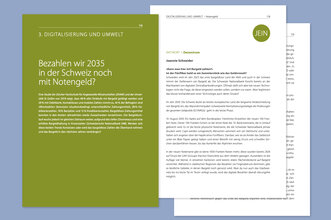Every four years, the Federal Chancellery publishes a situation and context analysis to provide the Federal Council with a foundation for its long-term planning. On behalf of the Federal Chancellery, Dezentrum has answered the question if we will still be paying with banknotes in 2035.
Situation and context analysis Cash for the Federal Chancellery
Every four years, the Federal Chancellery publishes a situation and context analysis to provide the Federal Council with a foundation for its long-term planning. On behalf of the Federal Chancellery, the Dezentrum has answered the question if we will still be paying with banknotes in 2035.

«Can I pay by cash?» Will the five-franc coin soon be a collector's item like the Goldvreneli?
Sweden becomes the world's first cashless country in 2023 and the value of cash is also declining in Switzerland: the Swiss National Bank is already researching the feasibility of digital central bank currencies. However, when it comes to new technologies, the question is often not whether they should be used, but when. But does the mere existence of a technology legitimize its use?
The year 2035: Switzerland is the last European country to announce the gradual phasing out of cash; «The Swiss-wide normalization strategy for changes to overall monetary policy (SCHNÄGG)» is entering its final phase.
August 10, 2035: An aperitif on the Bundesplatz. Ceremonial inauguration of the new 100-franc note. This 100-franc bill is the last note in the 10th banknote series to be put into circulation. It is the last physical note series that the Swiss National Bank will ever print. Champagne is passed around, people are gathered at the bar tables and talk excitedly about the feel of a five-franc note. They talk about how as children they used to place the coin under a piece of paper and run a pencil over it with little pressure and quick strokes until the image of the alphabet appeared.
There are no longer any 1000-franc notes in the new series; these were already withdrawn from circulation in 2024 under pressure from the FATF (Groupe d'action financière). In addition, the number of notes in circulation is much smaller, and in some cantons cash is already being phased out in almost all areas. While payment by fingerprint dominates in urban regions, there are rural areas where cash is still used. But now that the fiber optic network is being installed right down to the last valley in Ticino, digital payment will be possible everywhere without disruption.

The President of the Swiss Confederation gives a short speech in which she reaffirms the Swiss digitalization strategy, adding that yes, digitalization in Switzerland has not progressed quickly. But if you look at the surrounding countries, it becomes clear that the overall package of measures was the only right way to go. And let's be honest, when has Switzerland ever done anything like the other countries? And the audience laughs. She continues: «Personally, SCHNÄGG is particularly close to my heart. It was good and right to build a secure digital infrastructure first, like the e-ID or Suisse Servers. And I am proud that we took enough time to implement SCHNÄGG and thus guaranteed that every grandmother and every office worker knew how to make a digital payment with their wallet before it was only possible to pay everywhere using a fingerprint.»
In fact, as a late mover, Switzerland can benefit from the transfer of knowledge from other countries and thus prevent mishaps such as Munich 29, when the power blackout paralyzed the entire cashless payment system.
The democratic discourse on the future of cash was driven forward by Parliament's proactive behavior in 2022. During the autumn session, digitalization was an important point on the agenda: after the first population surveys, however, it became clear that not only the use of digital payment methods, but also digital skills varied greatly within society.
Strategie & Strategic Foresight
We offer comprehensive consulting and innovative methods to support organizations in the creation and implementation of future strategies.
The innovative aspect of SCHNÄGG at the time was that the strategy consisted of modular policies. This made it possible to present a package of measures that went beyond the lowest common denominator. These modules could be implemented as sunset policies by individual cantons, which not only strengthened federal competencies, but also evaluated the advantages and disadvantages of various programs. The modules included digital infrastructure programs, cybersecurity sensitization or start-up financing for cashless strategies of small companies.
How much leeway the cantons actually had in terms of implementation, i.e. whether it was really a decision to abolish cash by 2045, is debatable. The 2019-23 pandemic seasons led to a rapid increase in digital payment methods - even between private individuals, solutions such as TWINT were suddenly widespread. When the European Union introduced the e-euro in 2030, the pressure on Switzerland to develop a strategy for digital payment methods increased all the more. However, it cannot be ruled out that the Freedom of Transaction Movement will launch another referendum against the end of cash. Especially after the sudden end of Bitcoin, which was banned due to its negative climate footprint, the movement was able to acquire more members.
If everything goes as planned, the last banknotes and the last coin will still be used for payment until 2045. After that, the Alphirt will join the Goldvrenelis.
Contact
